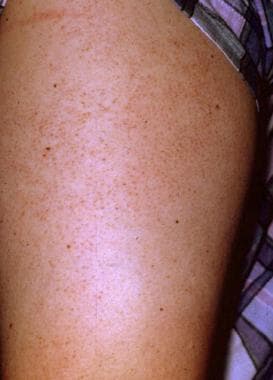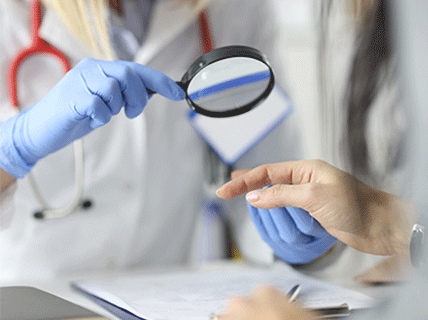Background
Keratosis pilaris (KP) is a genetic disorder of keratinization of hair follicles of the skin. It is an extremely common benign condition that manifests as small, rough folliculocentric keratotic papules, often described as chicken bumps, chicken skin, or goose-bumps, in characteristic areas of the body, particularly the outer-upper arms and thighs (see the image below). Although no clear etiology has been defined, KP is often described in association with other dry-skin conditions such as ichthyosis vulgaris, xerosis, and, less commonly, atopic dermatitis, including conditions related to asthma and allergies. [1]
KP is a common disorder in both children and adults. It is frequently noted in otherwise asymptomatic patients visiting dermatologists for other conditions. Most people with KP are unaware that the condition has a designated medical term or that it is treatable. In general, KP is frequently cosmetically displeasing but medically harmless.
Overall, KP is described as a condition of childhood and adolescence. Although it often becomes more exaggerated at puberty, it frequently improves with age. However, many adults have KP late into senescence. Approximately 30-50% of patients have a positive family history. Autosomal dominant inheritance with variable penetrance has been described. The autosomal recessive form of keratosis pilaris atrophicans is related to a desmoglein 4 mutation. [2]
Seasonal variation is sometimes described, with improvement of symptoms in summer months. Dry skin in winter tends to worsen symptoms for some groups of patients. Overall, KP is self-limited and, again, tends to improve with age in many patients. Some patients have lifelong KP with periods of remissions and exacerbations. More widespread atypical cases may be cosmetically disfiguring and psychologically distressing.
Various therapeutic interventions have been employed in the treatment of KP, but none have been proved to be curative or universally effective. [3] (See Treatment.) Assessment of their relative efficacy has been hindered by a lack of standardized and validated tools for assessing and scoring KP. [4, 5]
Pathophysiology
KP is a genetically based disorder of hyperkeratinization of the skin. Excessive formation or buildup of keratin is thought to cause the abrasive goose-bump skin texture. In these patients, the process of keratinization (formation of epidermal skin) is faulty.
One theory is that surplus skin cells build up around individual hair follicles. The individual follicular bumps may be caused by a hair that cannot reach the surface and becomes trapped beneath the keratin debris. Patients may develop mild erythema around the hair follicles, indicative of the inflammatory condition. Often, a small coiled hair is visible beneath the papule. Not all the bumps have associated hairs underneath. Papules are thought to arise from excessive accumulation of keratin at the follicular orifice.
Some experts have suggested that KP may not be a primary disorder of keratinization but, rather, a disorder of the hair shaft. Circular hair shafts rupture the follicular epithelium, leading to inflammation and abnormal follicular keratinization. [6]
Atrophy or absence of sebaceous glands has been identified as an early feature in the pathogenesis of KP. [7]
Certain drugs, like nilotinib, have been implicated as causes of KP or keratosis pilaris atrophicans. [8, 9]
Syndromal and familial cases often have a genetic component. [10, 11, 12]
Etiology
The etiology of KP has not been fully elucidated. A definite association with hyperkeratinization has been established. Of persons affected, 50-70% have a genetic predisposition. Autosomal dominant inheritance has been described. KP is known to be more common in siblings and in twins.
Dry-skin conditions seem to exacerbate the disease. Symptoms generally tend to worsen in winter and improve in summer. Common associations include several ichthyoses, especially ichthyosis vulgaris and atopic dermatitis. [13]
Epidemiology
US and international statistics
KP is overall a very common condition and is present worldwide.
The frequency of KP is increased in individuals with ichthyosis vulgaris and has been estimated at 74%. Many older reports claimed an increased incidence of KP in patients with atopic dermatitis, but more recent studies have not confirmed this association. In view of the high prevalence and intensity of KP noted during puberty and in women with hyperandrogenism, some experts have suggested that KP may be influenced by hormonal changes.
In India and other countries, a specific condition called erythromelanosis follicularis faciei et colli is described. This is an unusual condition with a possible genetic or other relationship to keratosis pilaris. Erythromelanosis follicularis faciei et colli is characterized by the triad of hyperpigmentation, follicular plugging, and erythema of the face and neck. [14, 15]
Age-, sex-, and race-related demographics
The onset of KP often occurs within the first decade of life: An estimated 51% of cases are diagnosed during this period, with 35% diagnosed during the second decade, 12% during the third, and 2% during the fourth. Symptoms particularly intensify during puberty. However, KP may manifest in persons of any age and is common in young children. Some authorities have maintained that individuals can outgrow the disorder by early adulthood, but often this is not the case.
Both sexes can be affected by KP, but females may be affected more frequently than males. [16]
KP has no widely described racial predilection or predominance. It is commonly noted worldwide in persons of all races.
Prognosis
The overall prognosis is good. Many cases resolve with increasing age; however, others may persist into late adulthood with intermittent exacerbations and remissions.
A study performed by Poskitt et al demonstrated the following [16] :
-
The condition dramatically improves in approximately 35% of patients, usually by late adolescence (mean age of improvement, 16 y)
-
The condition remains unchanged from the time of diagnosis in approximately 43% of patients
-
Approximately 20% of patients experience a worsening of symptoms over time
-
Approximately 50% experience a worsening of symptoms during wintertime, but only 60% of those who worsen improve over summertime
KP is not associated with increased mortality or morbidity. Often, patients are bothered by the cosmetic appearance of their skin and its rough, gooseflesh texture. Obesity has been implicated in a wide spectrum of dermatologic diseases, including KP. [17] KP is commonly present in otherwise healthy individuals and is not known to have any long-term health implications.
Patient Education
Patient education should focus on the tendency for chronicity of the condition and the need for ongoing maintenance therapy. Patients should also be advised that the condition is not contagious and is not a threat to their overall health. For patient education resources, see the Skin, Hair, and Nails Center.
-
Close-up view of keratosis pilaris. Keratotic follicular-based erythematous papules are noted on upper arm.
-
Keratosis pilaris in characteristic location on outer upper arm of 30-year-old woman.
-
Classic skin-colored bumps on upper arm of young White female twin. Image from The Skin Center of Laguna.
-
Keratosis pilaris on upper arm of twin female. Image from The Skin Center of Laguna.
-
Keratosis pilaris bumps on arm of White female twin. Image from The Skin Center of Laguna.
-
Keratosis pilaris on upper arm. Image from The Skin Center of Laguna.
-
Keratosis pilaris on upper arm of twin. Image from The Skin Center of Laguna.
-
Keratosis pilaris occurs most commonly on lateral upper arms and upper thighs.
-
Lesions of keratosis pilaris are evenly spaced, consistent with follicular origin of this disorder.
-
Bacteria associated with follicular papules of keratosis pilaris may cause some lesions to become erythematous or pustular.










